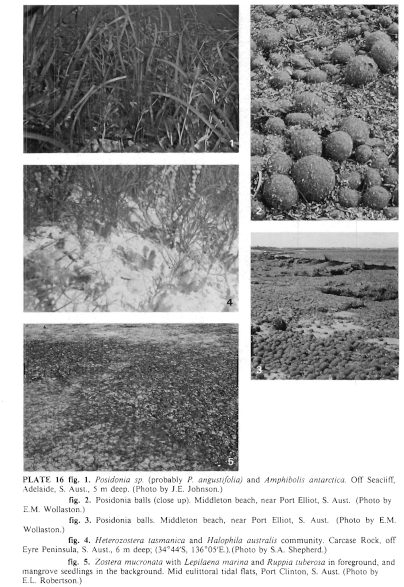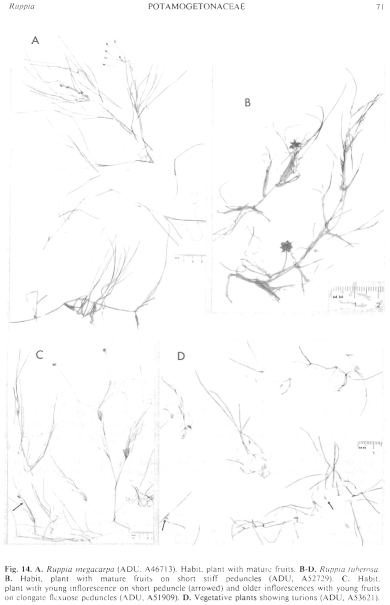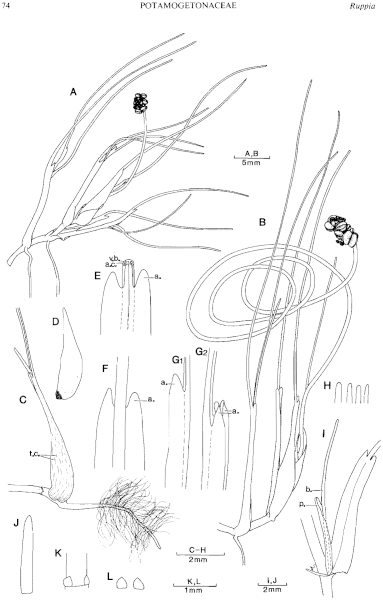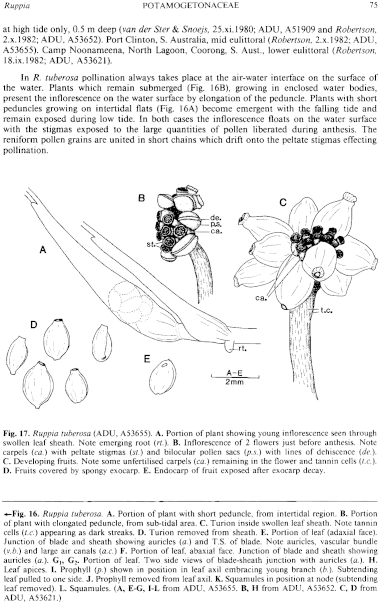|
|
|
|
|
|||||||||||
|
Electronic Flora of South Australia Species Fact Sheet
Phylum Magnoliophyta – Subphylum Seagrasses – Class Liliopsida – Subclass Alismatidae – Order Potamogetonales – Family Potamogetonaceae
Selected citations: Green 1981: 5.
Synonym
Ruppia maritima sensu Aston (in part) 1973: 290.
Annual or delicate short-lived perennial (Figs 14B–D, 16A, B) with slender rhizomes 0.5–1.5 mm in diameter. Stems very short, not conspicuous. Turions (Figs 14D, 16C, D) falcate, asymmetric, 2–6 mm long, 0.5–1 mm broad. Leaves (Fig. 16E–G) filiform; sheath 1–2 cm long, auricles rounded, 0.5–1.5 mm long, often unequal in length; blade (6–) 8–10 cm long, (0.1–) 0.2–0.3 (–0.5) mm broad; apex (Fig. 16H) rounded to acute, frequently finely serrulate. Prophylls (Fig. 161, J) lanceolate, 5–6 mm long. Squamules (Fig. 16K, L) ovate, 0.2–0.3 mm long. Inflorescence (Figs 14C, 16A, B, 17A, B) with 1–2 flowers, enclosed in the inflated leaf sheaths at first, peduncle 3–30 cm or more in length (dependent on water depth), becoming tightly spirally coiled (Fig. 16B) and retracting the fruits after fertilisation. Carpels (Fig. 17B, C) (6–) 8–12 (–26), sessile or subsessile. Fruits (Figs 14B, 17C, D) pyriform, usually symmetric, (1.2–) 1.8–2.0 (–2.5) mm long; exocarp fleshy, decaying early; endocarp (Fig. 17E) dark-brown or black, smooth, (1.0)1.4–1.7 (–2.0) mm long, with a short thin beak about 0.1 mm long, a longitudinal ridge and an ovate perforation on each side; podogyne absent (or rarely about 1.5 mm, but never as long as the fruit, and not persistent after the exocarp decays).
Type from Shark Bay, W. Aust. (J. S. Davis, 5.ix.1970), apparently lost; neotype in FLAS, 137470 (see Jacobs & Brock 1982, p. 331).
Selected specimens: Goldsmith Beach (near Edithburgh), Yorke Peninsula, S. Aust., mid eulittoral (Robertson, 14.xi.1981; ADU, A52729). Coobowie Inlet, S. Aust., connected with sea at high tide only, 0.5 m deep (van der Ster & Snoejs, 25.xi.1980; ADU, A51909 and Robertson, 2.x.1982; ADU, A53652). Port Clinton, S. Australia, mid eulittoral (Robertson, 2.x.1982; ADU, A53655). Camp Noonameena, North Lagoon, Coorong, S. Aust., lower eulittoral (Robertson, 18.ix.1982; ADU, A53621).
Distribution: W. Aust., S. Aust. and Victoria. In ephemeral, or at the margins of permanent, saline water bodies such as lakes, inlets, estuaries and tidal lagoons in water from 10 cm to 1 m deep, and also in the mid to lower eulittoral on tidal flats in sheltered bays (Pl. 16 fig. 5) where it grows in association with Lepilaena marina and Zostera mucronata. This latter intertidal form of R. tuberosa (Fig. 14B) has rigid, short (3–10 cm) peduncles, inflorescences frequently 1-flowered, and numerous (up to 26) carpels per flower; it does not appear to produce turions.
Taxonomic notes: In R. tuberosa pollination always takes place at the air-water interface on the surface of the water. Plants which remain submerged (Fig. 16B), growing in enclosed water bodies, present the inflorescence on the water surface by elongation of the peduncle. Plants with short peduncles growing on intertidal flats (Fig. 16A) become emergent with the falling tide and remain exposed during low tide. In both cases the inflorescence floats on the water surface with the stigmas exposed to the large quantities of pollen liberated during anthesis. The reniform pollen grains are united in short chains which drift onto the peltate stigmas effecting pollination.
Turions in Ruppia spp. act as perennating organs allowing the plant to withstand desiccation. They appear to be initiated as salinity increases but may sometimes be formed at salinities less than that of seawater (Brock 1982b). The term "turion" was first applied to these starch-filled storage organs in R. tuberosa by Davis & Tomlinson (1974). However, their presence, under the name of "tubers" has been known for many years. In the Coorong, South Australia, they form an important food item of duck and other waterfowl which congregate in the late spring and summer, and systematically graze on Ruppia spp., eating both seeds and turions (Delroy, Macrow & Sorrell 1965, Delroy 1974).
References:
BROCK, M.A. (1982b). Biology of the salinity tolerant genus Ruppia L. in saline lakes in South Australia. 2. Population ecology and reproductive biology. Aquat. Bot. 13, 249–268.
DAVIS, J.S. & TOMLINSON, P.B. (1974). A new species of Ruppia in high salinity in Western Australia. J. Arnold Arbor. Harv. Univ. 55, 59–66.
DELROY, L.B. (1974). The food of waterfowl (Anatidae) in the southern Coorong saltwater habitat of South Australia. J. S. Aust. Ornithol. Ass. 26, 157–163.
DELROY, L.B., MACROW, P.M. & SORRELL, J.B. (1965). The food of water-fowl (Anatidae) in salt water habitats of South Australia. Fisheries and Fauna Conservation Department, South Australia. Report (unpubl.).
GREEN, J.W. (1981). Census of the Vascular Plants of Western Australia. (Western Australian Herbarium: South Perth.)
JACOBS, S.W.L. & BROCK, M.A. (1982). A revision of the genus Ruppia (Potamogetonaceae) in Australia. Aquat. Bot. 14, 325–337.
The Marine Benthic Flora of Southern Australia Part I complete list of references.
Publication:
Womersley, H.B.S. (31 May, 1984)
The Marine Benthic Flora of Southern Australia
Part I
©Board of the Botanic Gardens and State Herbarium, Government of South Australia
Illustrations in Womersley Part I, 1984: PLATE 16 fig. 5; FIGS 14 B–D, 16, 17.

Plate 16 enlarge
PLATE 16 Fig. 1. Posidonia sp. (probably P. angustifolia) and Amphibolis antarctica. Off Seacliff, Adelaide, S. Aust., 5 m deep. (Photo by J.E. Johnson.)
Fig. 2. Posidonia balls (close up). Middleton beach, near Port Elliot, S. Aust. (Photo by E.M. Wollaston.)
Fig. 3. Posidonia balls. Middleton beach, near Port Elliot, S. Aust. (Photo by E.M. Wollaston.)
Fig. 4. Heterozostera tasmanica and Halophila australis community. Carcase Rock, off Eyre Peninsula, S. Aust., 6 m deep; (34°44'S, 136°05'E.). (Photo by S.A. Shepherd.)
Fig. 5. Zostera mucronata with Lepilaena marina and Ruppia tuberosa in foreground, and mangrove seedlings in the background. Mid eulittoral tidal flats, Port Clinton, S. Aust. (Photo by E.L. Robertson.)

Figure 14 enlarge
Fig. 14. A. Ruppia megacarpa (ADU, A46713). Habit, plant with mature fruits. B–D. Ruppia tuberosa. B. Habit, plant with mature fruits on short stiff peduncles (ADU, A52729). C. Habit, plant with young inflorescence on short peduncle (arrowed) and older inflorescences with young fruits on elongate flexuose peduncles (ADU, A51909). D. Vegetative plants showing turions (ADU, A53621).

Figure 16 enlarge
Fig. 16. Ruppia tuberosa. A. Portion of plant with short peduncle, from intertidal region. B. Portion of plant with elongated peduncle, from sub-tidal area. C. Turion inside swollen leaf sheath. Note tannin cells (t.c.) appearing as dark streaks. D. Turion removed from sheath. E. Portion of leaf (adaxial face). Junction of blade and sheath showing auricles (a.) and T.S. of blade. Note auricles, vascular bundle (v.b.) and large air canals (a.c.) F. Portion of leaf, abaxial face. Junction of blade and sheath showing auricles (a.). G1,G2. Portion of leaf. Two side views of blade-sheath junction with auricles (a.). H. Leaf apices. L Prophyll (p.) shown in position in leaf axil embracing young branch (b.). Subtending leaf pulled to one side. J. Prophyll removed from leaf axil. K. Squamules in position at node (subtending leaf removed). L. Squamules. (A, E–G,I–L from ADU, A53655. B, H from ADU, A53652. C, D from ADU, A53621.)

Figure 17 enlarge
Fig. 17. Ruppia tuberosa (ADU, A53655). A. Portion of plant showing young inflorescence seen through swollen leaf sheath. Note emerging root (rt.). B. Inflorescence of 2 flowers just before anthesis. Note carpels (ca.) with peltate stigmas (st.) and bilocular pollen sacs (p.s.) with lines of dehiscence (de.). C. Developing fruits. Note some unfertilised carpels (ca.) remaining in the flower and tannin cells (t.c.). D. Fruits covered by spongy exocarp. E. Endocarp of fruit exposed after exocarp decay.

|
Email Contact: State Herbarium of South Australia |

|